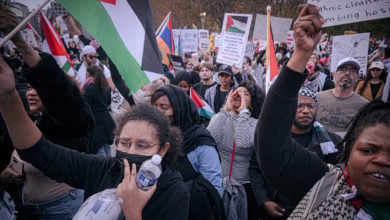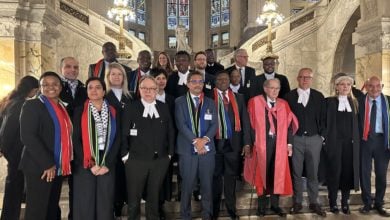Day by day, the Iraqi resistance to U.S. occupation is growing and intensifying. In the wake of the April 9 massive anti-occupation demonstration in Najaf, Iraq has erupted in a paroxysm of violence.
The Associated Press reported that 233 people were killed on April 18 throughout Iraq, making it the second deadliest
|
The scene of the largest bombing was the Sadriyah marketplace in the center of Baghdad. 140 were reported killed, with a further 150 wounded. The bombing was the deadliest such attack in the four years since the U.S. invasion. Angry crowds at the scene denounced the Iraqi government and blamed the violence on the U.S. occupation.
That same day, Bush administration and congressional Democrats staged a White House meeting to discuss continued funding of the war at a cost of greater than $100 billion. The meeting was held to negotiate a “compromise” between Republicans and Democrats. The House and Senate approved separate bills, both of which provide even greater war funding than the White House had requested.
The bills propose loose timetables for withdrawing U.S. combat troops. These timetables contain a key loophole: the president can waive them at any time for reasons of “national security.” Meanwhile, they also propose continued deployment of tens of thousands of U.S. military personnel in an occupied Iraq for “counterterrorism operations,” training, supervising and “advising” Iraqi puppet forces, while protecting US assets, chiefly Iraqi oil.
The legislation reaffirms a crucial fact. The Democrats are as much a party of imperialism as the Republicans. They are incapable of halting the war.
Framing the violence throughout Iraq is a recent report from the Brookings Institution, a pro-imperialist U.S. research institute. The report concluded that 75 percent of attacks are directed at occupation forces, while a further 17 percent are directed at puppet Iraqi forces. This means that at least 92 percent of all attacks are directed at U.S. forces or its proxies.
Moreover, the resistance continues to intensify. The average number of attacks has more than doubled in the past year to about 185 a day. Those numbers add up to 1,300 a week, and more than 5,500 a month.
With little notice in the corporate media, the death toll for U.S. troops has risen dramatically. Since the beginning of the “surge” in February, 226 American troops have died. In the past six months, more than 535 American troops have been killed, the bloodiest half-year for US forces since the war began.
Taken together, the numbers are unequivocal. The so-called “civil war” in Iraq is a myth. The war is aimed squarely at the U.S. occupation, and it is growing stronger by the day.
To combat this intensifying resistance, the U.S. occupiers are turning to ever-more desperate measures, measures which fly in the face of the conclusions of the Brookings report.
‘No to the sectarian wall’
Last week came reports that a U.S. military brigade is constructing a three-mile-long concrete wall to cut off one of Baghdad’s Sunni Arab districts from the Shiite Muslim neighborhoods that surround it. U.S. commanders in northern Baghdad say the 12-foot-high barrier will make it harder for suicide bombers, and militia fighters to launch attacks and then slip back to their home turf. Construction has begun and is expected to be completed by the end of the month.
Although Baghdad is already littered with blast walls, checkpoints and other temporary barriers, the wall being constructed in Adhamiya would be the first to divide a neighborhood by sect.
Sunnis and Shiites living in the shadow of the barrier are united in their contempt for the imposing new structure. “Are they trying to divide us into different sectarian cantons?” asked a Sunni drugstore owner in Adhamiya. “This will deepen the sectarian strife and only serve to abort efforts aimed at reconciliation.”
Several residents interviewed likened the project to the massive barriers built around some Palestinian zones in Israel. “Are we in the West Bank?” asked Abu Qusay, a 48-year-old pharmacist.
“I feel this is the beginning of a pattern of what the whole of Iraq is going to look like, divided by sectarian and racial criteria,” said Abu Marwan.
On April 25, Shiite cleric Muqtada al-Sadr called for demonstrations against the wall. Al-Sadr said in a statement that Iraqis reject “the sectarian, racist and unjust wall that seeks to divide” Sunnis and Shiites. “I am confident that such honorable voices will bring down the wall,” he said.
The new wall is not the first time U.S. military planners have attempted to isolate hostile regions. In 2005, U.S. troops tried to surround the Sunni-dominated city of Samarra with earthen berms to prevent insurgents from entering and leaving the city. A similar strategy was deployed to contain Tal Afar.
Such measures surely will end in failure. As the ever-growing resistance of the Iraqi people makes clear, the violence will subside only when the U.S. occupation ends.







